Sustainable aquaculture is an increasingly important practice for meeting the growing demand for seafood in a way that is environmentally and socially responsible. This approach to aquaculture seeks to minimize negative environmental impacts and ensure the long-term viability of aquatic organisms, such as fish, shellfish, and seaweed, by adopting responsible farming methods.
There are many aspects of sustainable aquaculture, but five key areas stand out as essential components of this approach. These include environmental responsibility, animal welfare, responsible feed, social responsibility, and certification. In this article, we will explore these five aspects of sustainable aquaculture in more detail and discuss why they are critical for the health of our oceans, the welfare of the animals being farmed, and the sustainability of the industry as a whole.
There are many aspects of sustainable aquaculture, but here are five key aspects:
- Environmental Responsibility: Sustainable aquaculture prioritizes the health of the aquatic environment and the ecosystem in which the farm operates. This includes responsible use of water, minimizing waste and pollution, reducing energy consumption, and preventing negative impacts on the surrounding natural habitat.
- Animal Welfare: Sustainable aquaculture ensures the health and welfare of the animals being farmed. This involves providing appropriate feeding and husbandry, reducing stress levels, preventing disease outbreaks, and minimizing the use of antibiotics and other chemicals.
- Responsible Feed: Sustainable aquaculture uses a feed that is sourced from sustainable sources and does not contribute to overfishing or other negative environmental impacts. This includes exploring alternative sources of feed, such as plant-based feeds or feeds that use insects or algae.
- Social Responsibility: Sustainable aquaculture operates in a socially responsible way that respects the rights of workers, contributes to the local economy, and ensures the health and safety of the community in which it operates.
- Certification: Sustainable aquaculture can be certified through recognized certification schemes, such as the Aquaculture Stewardship Council (ASC) and the Best Aquaculture Practices (BAP) certification, which set standards for responsible farming practices and offer assurance to consumers that the products they are purchasing are sustainably produced.

Sustainable aquaculture seeks to address these challenges by implementing a range of innovative techniques and technologies. For example, some farmers are adopting closed-loop systems, which recycle water and minimize waste discharge, reducing the impact on surrounding waters. Others are using natural methods to control pests and diseases, such as introducing predator fish to control parasites or using probiotics to boost the immune systems of their stock.
Use sustainable feed
Another key aspect of sustainable aquaculture is the use of sustainable feeds. Traditionally, fishmeal and fish oil, derived from wild-caught fish, have been used as feed for farmed fish. However, this is not a sustainable approach as it contributes to overfishing and puts additional pressure on wild fish stocks. To address this, many farmers are exploring alternative sources of feed, such as plant-based feeds, which reduce the reliance on wild fish and are more environmentally friendly.
Responsible management practices
Sustainable aquaculture also involves responsible management practices that prioritize the welfare of the aquatic environment and the animals being farmed. This includes monitoring water quality, preventing disease outbreaks, and ensuring that the animals are kept in conditions that are conducive to their health and well-being. This can be achieved through certification schemes, such as the Aquaculture Stewardship Council (ASC) and the Best Aquaculture Practices (BAP) certification, which set standards for responsible farming practices and offer assurance to consumers that the products they are purchasing are sustainably produced.
Our responsibilities:
We all have a role to play in promoting and supporting sustainable aquaculture. As consumers, we can choose to purchase seafood that has been sustainably farmed and certified. This means looking for labels such as the Aquaculture Stewardship Council (ASC) and the Best Aquaculture Practices (BAP) certification.
As producers and farmers, we can adopt innovative technologies and practices that prioritize the health of the aquatic environment and the welfare of the animals being farmed. This includes using sustainable feeds, responsible waste management, and reducing energy consumption.
Governments and policymakers also have a critical role to play in promoting and supporting sustainable aquaculture. They can create incentives for producers to adopt sustainable practices, invest in research and development, and regulate the industry to ensure that it operates in a responsible and sustainable manner.
Conclusion:
Sustainable aquaculture is an important practice for meeting the growing demand for seafood in a way that is environmentally and socially responsible. By adopting innovative techniques and technologies, using sustainable feeds, and implementing responsible management practices, farmers can ensure that they are not only meeting the needs of consumers but also protecting the long-term health of the aquatic environment and the animals being farmed.
In conclusion, sustainable aquaculture is essential for the long-term health of our oceans and our planet. By taking action to promote and support sustainable aquaculture, we can ensure that future generations can continue to enjoy the benefits of healthy and abundant seafood while protecting our environment and the welfare of the animals being farmed.
Join our EAT Community to Learn more about sustainable aquaculture.



